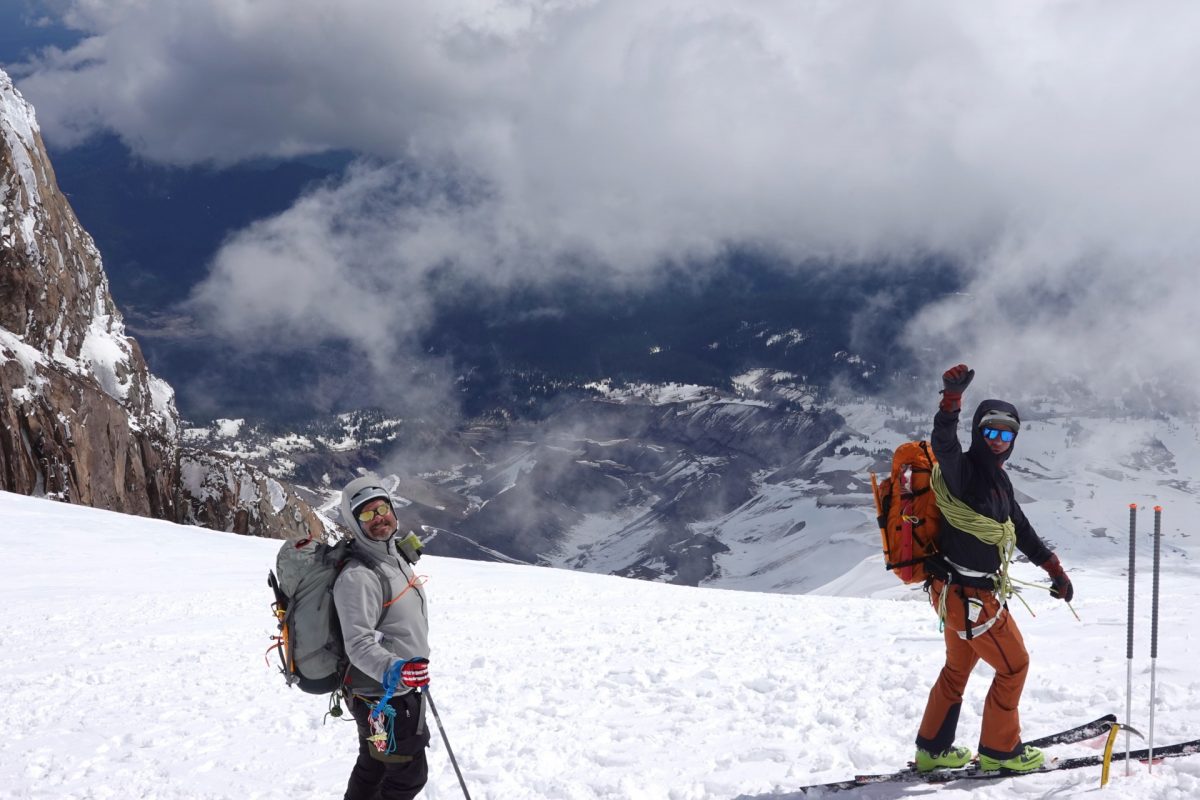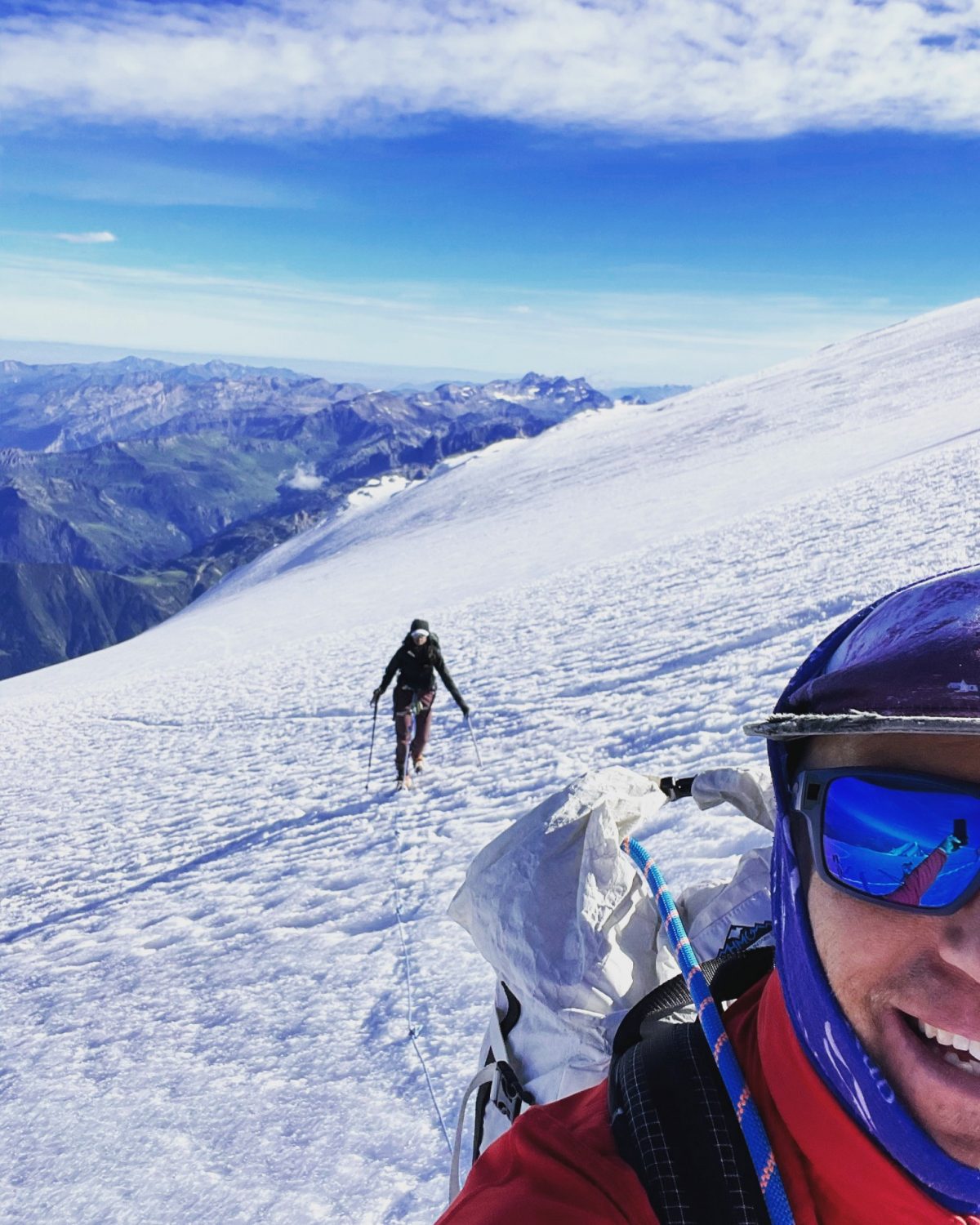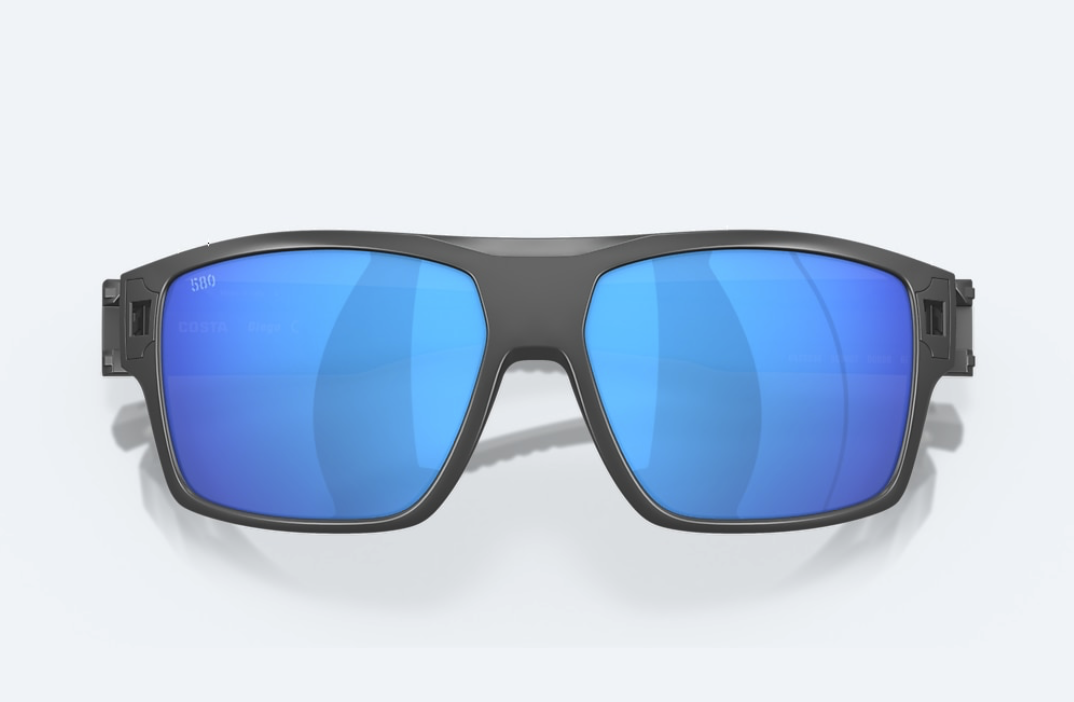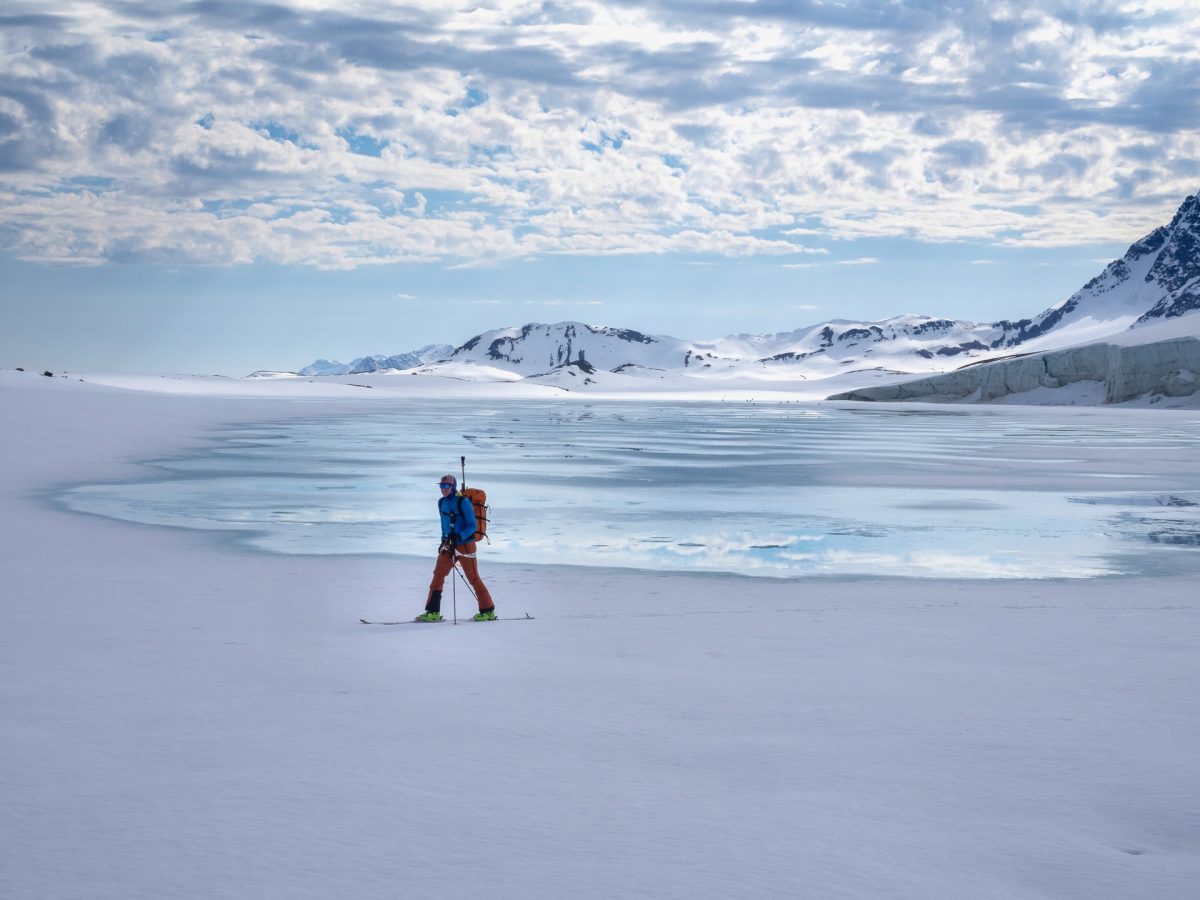
The author and a client on their Mt. Hood ski descent. There’s no doubt that Rob (hand raised), is protecting his precious soul-windows from the sun’s damaging rays.
Part style stamement, part eye protection; a solid sunglass is a key part of a backcountry skier/rider’s kit. And why not adopt what works in the realm of those seeking solace catching fish. Polarized lenses do wonders. Here’s a look at the Costa Diego sunglass.
Eyes are the windows to the soul … so the old proverb goes. Attribution for this oft-uttered phrase ranges from Shakespeare to the Bible (Matthew 6:22) to Cicero to some balding pony-tail guy with a Ted Talk. That’s a reputable list of experts, especially in this age of fake news pundits and QAnon kooks, so let’s just agree that somebody important said it.
Protecting our precious soul-windows from the sun’s damaging rays should be tops on the list for skiers and alpinists. Not to mention I don’t need a bunch of strangers peering into the unwashed corners of my blackened soul, now that I think of it.
Sunglasses. High-quality sunglasses are the answer! Essential equipment for the eyes, to be sure, and I’ve just stumbled upon the best pair of glasses I’ve ever owned – the Costa del Mar “Diego”.
The Costa Fishing Glasses … on Snow?
Anybody into fishing, in particular, knows Costa del Mar as a premium brand of sunglasses. They’re marketed to anglers as superior for bright conditions, particularly around water. Costa polarizes every model to reduce glare.
An old friend of mine, himself a professional fishing guide, was wearing Costas during a visit to see us in Seattle last spring. He raved about them, so I stole ‘em for a couple hours in town. Great optics and all, but strolling to get a slice hardly presents the conditions ski mountaineers and alpinists experience. “Seem like nice glasses,” I thought, and forgot about them.
Not a week later, I swear, I received an email from a renowned PR agency asking if I’d like to try a pair of … Costa del Mar “Diego” sunglasses. What a coincidence, and of course, I’d love to! Consider this full disclosure that I received the Costas free of charge ($294 retail), but I tell you honestly, if I didn’t love them, I would’ve just quietly returned them and spared you the following blathering.
But I do love them – for skiing, climbing, driving, and yes, even a day on the river (rafting, not fishing, but hey … it was water)! In summary, I can’t recommend the Costa “Diego” highly enough for anything in the mountains.

Ascending the flanks of Mont Blanc, the author looking mountain casual in the Diegos.

The sunglass proved to be well suited to mountain guide life, which on occasion, includes a beach stop. Yet in the high alpine, these specs are worthy.
Ski, Climb, Hang in the Diego
Costa makes dozens of models for both men and women, and I’ll discuss the frame style in a sec, but for the moment, let’s talk lenses. Costa produces the Diego with its “580” lens. Most Costa models come in various lens colors, not to mention a choice of materials. I opted for the 580P – the P standing for polycarbonate, or plastic. The 580G – you guessed it – is made of glass.
(Noteworthy: my buddy’s Diegos were glass, and though I didn’t try them on side-by-side with the polycarbonate version, I didn’t notice a big drop in clarity between the two. Costa claims their glass lenses are substantially lighter than most. Now I’m jonesing for a pair of glass-lensed Costas for driving and town!)
While glass offers better optics and more scratch resistance, they’re also heavier and could shatter in the event of an impact. I’ve never heard of this happening to a skier, but hey, we’re all just one caught edge from being Jerry of the Day, so wearing glass over my dreamy soul-windows doesn’t seem like a good idea while I’m on the send-train (read: middle-aged mountain guide trying not to embarrass himself). Punchline: I opted for the lighter weight, impact-resistance 580P lens.
Costa offers seven different lens colors, from “Blue Mirror” for “open reflective water” to a Gray for everyday activities to “Sunrise Silver Mirror” for low-light situations. I went with the Blue Mirror, thinking that open reflective water would most closely mimic sunshine on snow.
Diegos on Mont Blanc, Mount Hood, the Methow, and the Beach
When buying a sunglass from Vuarnet, Julbo, or Cebe (just to name a few), they’re often offered in four different categories, from 1 through 4 – category 4 being the most protective and suited to high altitude and super-bright conditions like glacier skiing. Costa doesn’t rate their glasses this way, but provides some suggestions for environmental conditions, as I mentioned above.
I had work on Mt. Hood (skiing) and Mt. Baker (walking/slogging) right after I received the Diegos, so I brought them along, but also brought along a category-4 Julbo sunglass, just in case the Costa lens felt too light at higher altitude and on a bright, sunny day on a glacier. Luckily for me and my guests, we had great weather for both trips and I wore the Diegos to the summits of both peaks (11,249 ft. and 10,786 ft., respectively).
While the 580P Blue Mirror lens doesn’t filter as much visible light (90% for the Costa Blue Mirror vs. 95% for my Julbos, for example) as category-4 lenses, I didn’t experience much eye fatigue or strain, even after all-day climbs and skis. After several long days in the mountains, I quit bringing along a back-up pair of cat-4 glasses.
I tried tracking down a Costa engineer to ask how the 580 Blue Mirror lens stacks up against a category-4 lens, but it was summer OR timing, and things were busy. Next time!
Costa’s website says they designed the 580 lens to block “high-energy blue light,” which is still a visible wavelength (380-430Nm, to be precise) and harsh yellows (580Nm – hence the name?). By cutting those wavelengths, the lenses enhance other colors. It’s supposed to reduce haze and enhance clarity too, and of course, it filters 100% of the UV rays. Obviously, I have no means to verify any of that techy stuff, but I can say the optics are great in everything from the brightest sun on water and snow, down to light overcast (but still relatively bright) conditions.
I wore the Diegos a bunch throughout the summer, including a rafting trip on the Methow and a month working in the French Alps. By July, I had so much confidence in the Costa lenses, I climbed the Mont Blanc (15,770 ft.) in them. We watched sunrise over the mountain, and then I spent the rest of the day in the glasses, returning to the refuge at 3:30 in the afternoon. (I also spent a week on the beach after my work, so I can assure you the Diego is up to the task of slothing in the sunshine.)
Overall, I got a very good sense of the Blue Mirror lens, and I would recommend them without reservation. (In fact, my experience only left me curious about how Costa’s lower-light lenses would perform on cloudy days and during storms.) I can’t think of a single negative for the Blue Mirror, 580p lenses. Zero scratches after 50+ days in the field (I babied them as much as I could), no drop in performance, and the coating has remained durable. Superb lenses and Costa offers a prescription version, too.

The author in Svalbard, Norway. This is the place to be Polar bear aware and sunglasses aware. The Diegos offer ample eye protection in high UV environments. Photo: Howie Garber.
The Frames
Maybe you’re sold on the lenses, but any obsessed skimo practitioner knows that frames matter, too. The Diego uses “Bio-Resin,” derived from the seeds of the castor plant, for its frame material. I wouldn’t have recognized the difference from plain plastic in terms of feel and performance, had I not read about it on the website, so kudos to them for sourcing a sustainable material rather than using dinosaur oil.
Give a look at the Diego and if you don’t like the style, Costa probably makes something you’ll dig. The Diego has an “XL” lens, but they describe the frame as “regular” sized. This sounds counterintuitive at first, but I can say – the lens does cover a wide field of vision, but the frames themselves aren’t necessarily for larger heads.
I typically wear the L/XL size in a Petzl or Black Diamond helmet, and have an adjustable-back ball cap on its last one or two snaps. When I raised the Diegos to put the glasses up on my head, I could feel the frame flex a bit. This resulted in them sliding down occasionally, as they were bowed a bit rather than appropriately fit too my head. I’m sure I could find another Costa frame that’s slightly wider and would fit over my melon-sized head a bit better – give a look on the Costa site and they have a useful fitting guide. So, in terms of sizing – do a little homework and choose wisely.
The Diego also has a “high bridge fit,” meaning that if the bridge of your nose is above the line of your pupils, they’ll fit better. See what I mean? Bunches of info on the site, so dive in and discover what might work – or better yet, find a shop that stocks Costas and try them on.
The Diegos have a small hole at each side of the frame (where the temple attaches), which allows air to flow into the space between your eyes and the lens. For a larger coverage lens, I was surprised at how well they resisted fogging, even on the up. I’m usually the guy in the back row at hot yoga, with two towels and a puddle below my impressive dad-bod, so resisting fogging is no small feat!
The Diego frame doesn’t have any sort of dedicated side-shield like a glacier glass might, but I didn’t notice any unwanted light sneaking in the sides. I think the XL lens offers enough wrap-around protection for most of us.
The temples feature some grippy material at the ears and small holes at the end for a keeper cord (included). I found the keeper cord a bit long, and it would end up snagging in my Buff or among my helmet straps. Given how much I like the Diegos, though, I committed to using a cord in the hopes I don’t drop the glasses and damage them. (I haven’t yet, thankfully!)
The Endorsement
All this is to say – the Costa del Mar Diego makes a great sunglass for skiing, climbing, and protecting the beautiful windows to your soul. They’re a bit spendy, for sure, but I have spent dozens of days in them, traveled with them, stashed them in packs while climbing and skiing, and they are by far my number-one sunglass for bright conditions. I realize $300 is a lot to spend, but for me, I’d rather have this one pair of sunglasses than several others I currently own. I’m a convert, and my next sunglass will be a low-light Costa del Mar to go with my Diegos.
Rob Coppolillo is a mountain guide and writer, based on Vashon Island, in Puget Sound. He’s the author of The Ski Guide Manual.
